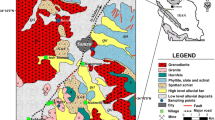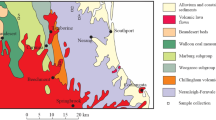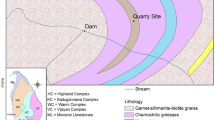Abstract
Predicting changes in rocks’ physical and mechanical properties due to weathering progress is among the most challenging scientific topics in engineering geology. This study investigated the role of weathering process in changing the geotechnical characteristics of some samples with different weathering degrees from the Shirkuh batholith (west of Yazd, Iran). Based on the results of XRF analysis, some chemical weathering indices were calculated for the samples, and their correlations with physical and mechanical properties were studied. The results indicated that the chemical indices defined based on mobile oxides such as CaO, K2O, and Na2O show a good correlation (0.98 > R2 > 0.70) with the geotechnical properties. Also, new mechanical and chemical weathering indices were defined based on the textural characteristics of the rock samples. The mechanical weathering index (MWI), which indicates the degree of quartz fragmentation, showed more ability to estimate geotechnical properties than the chemical weathering index (ChWI), which defines the degree of sericitization of feldspars. In addition, MWI showed strong correlations with the mechanical properties with R2 values more than 0.80, while the correlations were poor to fair for ChWI (R2 < 0.60). Moreover, REE/Al showed a relatively meaningful trend with the progress of weathering; however, due to the dependence of this ratio on factors other than weathering, its use is not recommended to explain the weathering process. Furthermore, some elements and oxides (e.g., CaO, P2O5, K2O, Na2O, V, Sr, and Ni) showed good potential to predict the weathering degree.













Similar content being viewed by others
Abbreviations
- MWI:
-
The mechanical weathering index
- ChWI:
-
Chemical weathering index
- XRF:
-
X-ray fluorescence
- XRD:
-
X-ray diffractometer
- CLI:
-
Chemical leaching index
- CWPI:
-
Chemical weathering product index
- TCWI:
-
Total chemical weathering index
- WPI:
-
Weathering potential index
- LOI:
-
Loss in ignition
- I mob :
-
Mobiles index
- MWPI:
-
Modified weathering potential index
- VR:
-
Vogt’s ratio
- CIA:
-
Chemical index of alteration
- SCH:
-
Schmidt hardness
- n e :
-
Effective porosity
- γ:
-
Density
- I d :
-
Slake durability index
- V p :
-
P-wave velocity
- I S-V0 :
-
Point load index
- REE:
-
Rare earth elements
- QAI:
-
Quick absorption index
- R:
-
Ruxton ratio
- CWI:
-
Chemical weathering index
- ICV:
-
Index of compositional variability
- PIA:
-
Plagioclase index alteration
- WIP:
-
Weathering potential index
- PWI:
-
Product of weathering index
- CIW:
-
Chemical index of weathering
- AI:
-
Alteration index
References
Alavi M (1991) Sedimentary and structural characteristics of the Paleo-Tethys remnants in northeastern Iran. Geol Soc Am Bull 103:983–992
Alavi M (2004) Regional stratigraphy of the Zagros fold-thrust belt of Iran and its proforeland evolution. Am J Sci 304(1):1–20
Arel E, Tugrul A (2001) Weathering and its relation to geomechanical properties of Cavusbasi granitic rocks in northwestern Turkey. Bull Eng Geol Environ 60:123–133
Arıkan F, Ulusay R, Aydın N (2007) Characterization of weathered acidic volcanic rocks and a weathering classification based on a rating system. Bull Eng Geol Env 66:415. https://doi.org/10.1007/S-I0064-007-0087-0
ASTM (2008) Standard test method for slake durability of shales and similar weak rocks, (D4644–04). ASTM International West Conshohocken, PA
Aydin A (2008) ISRM suggested method for determination of the Schmidt hammer rebound hardness: revised version. The ISRM Suggested Methods for Rock Characterization, Testing and Monitoring: 2007–2014. Springer. pp 25–33
Aydin A (2013) Upgraded ISRM suggested method for determining sound velocity by ultrasonic pulse transmission technique. The ISRM Suggested Methods for Rock Characterization, Testing and Monitoring: 2007–2014. Springer. pp 95–99
Basu A, Celestino TB, Bortolucci AA (2009) Evaluation of rock mechanical behaviors under uniaxial compression with reference to assessed weathering grades. Rock Mech Rock Eng 42:73–93. https://doi.org/10.1007/s00603-008-0170-2
Berberian M, King GCP (1981) Towards a paleogeography and tectonic evolution of Iran. Can J Earth Sci 18:210–265
Borrelli L, Coniglio S, Critelli S, La Barbera A, Gullà G (2016) Weathering grade in granitoid rocks: the San Giovanni in Fiore area (Calabria, Italy). J Maps 12(2):260–275
Bourgès A (2006) Holistic correlation of physical and mechanical properties of selected natural stones for assessing durability and weathering in the natural environment. lmu
Cano M, Tomás R (2016) Proposal of a new parameter for the weathering characterization of carbonate flysch-like rock masses: the potential degradation index (PDI). Rock Mech Rock Eng 49:2623–2640. https://doi.org/10.1007/s00603-016-0915-2
Ceryan Ş (2008) New chemical weathering indices for estimating the mechanical properties of rocks: a case study from the Kürtün Granodiorite, NE Turkey. Turkish Journal of Earth Sciences 17:187–207
Ceryan S, Zorlu K, Gokceoglu C, Temel AB (2008) The use of cation packing index for characterizing the weathering degree of granitic rocks. Eng Geol 98(1–2):60–74
Chiu C, Ng CW (2014) Relationships between chemical weathering indices and physical and mechanical properties of decomposed granite. Eng Geol 179:76–89
Cox K, Bell J, Pankhurst R (1979) The interpretation of igneous rocks George Allen and Unwin. London, United Kingdom 450
Cox R, Lowe DR, Cullers R (1995) The influence of sediment recycling and basement composition on evolution of mudrock chemistry in the southwestern United States. Geochim Cosmochim Acta 59:2919–2940
Dan MFA, Md M, Edy Tonnizam I, Komoo A, Madun MK, Abu Talib PJ, Ramadhansyah A, Mohd Taib DZ, Abang Hasbollah Z, Yusof Md, Noorasyikin MN (2023) Physico-mechanical characteristics of tropical granite boulders in weathered heterogeneous zones for geotechnical design purposes. Physics and Chemistry of the Earth, Parts a/b/c 129:103311
Davoudian AR, Genser J, Neubauer F, Shabanian N (2016) 40Ar/39Ar mineral ages of eclogites from North Shahrekord in the Sanandaj-Sirjan Zone, Iran: implications for the tectonic evolution of Zagros orogeny. Gondwana Res 37:216–240
Fedo CM, Wayne Nesbitt H, Young GM (1995) Unraveling the effects of potassium metasomatism in sedimentary rocks and paleosols, with implications for paleoweathering conditions and provenance. Geology 23:921–924
Foster MD (1960) Interpretation of the composition of trioctahedral micas: U.S. Geol. Surv. Prof. Pap. 354-B, 49 pp
Franklin J (1985) Suggested method for determining point load strength. International Journal of Rock Mechanics and Mining Sciences & Geomechanics Abstracts. Elsevier. pp 51–60
Freire-Lista DM, Gonçalves GV, Vazquez P (2022) Weathering detection of granite from three asynchronous historical quarries of Sabrosa municipally (North Portugal). J Cult Herit 58:199–208
Gresens RL (1967) Composition-Volume Relationships of Metasomatism Chemical Geology 2:47–65
Gullà G, Matano F (1997) Surveys of weathering profile on gneiss cutslopes in Northern Calabria, Italy. Proceedings of the IAEG sponsored international symposium “Engineering geology and the environment,” vol 1. AA Balkema Publishers, pp 133–138
Gupta AS, Rao SK (2001) Weathering indices and their applicability for crystalline rocks. Bull Eng Geol Env 60:201–221
Harnois L, Moore JM (1988) Geochemistry and origin of the Ore Chimney Formation, a transported paleoregolith in the Grenville Province of southeastern Ontario, Canada. Chem Geol 69:267–289
Heidari M, Momeni A, Naseri F (2013) New weathering classifications for granitic rocks based on geomechanical parameters. Eng Geol 166:65–73
Heinrichs K, Fitzner B (2011) Assessment of weathering damage on the petroglyphs of Cheonjeon-ri, Ulsan, Republic of Korea. Environmental Earth Sciences 63:1741–1761. https://doi.org/10.1007/S-I2665-010-0828-4
Ietto F, Perri F, Cella F (2018) Weathering characterization for landslides modeling in granitoid rock masses of the Capo Vaticano promontory (Calabria, Italy). Landslides 15:43–62. https://doi.org/10.1007/S-I0346-017-0860-5
Irfan T, Dearman W (1978) Engineering classification and index properties of a weathered granite. Bull Eng Geol Environ 17(1)
Irfan TY (1996) Mineralogy, fabric properties and classification of weathered granites in Hong Kong. Q J Eng GeolHydrogeol 29(1):5–35
Khanlari GR, Heidari M, Momeni AA (2012) Assessment of weathering processes effect on engineering properties of Alvand granitic rocks (west of Iran), based on weathering indices. Environmental Earth Sciences 67:713–725. https://doi.org/10.1007/S-I2665-011-1518-6
Khodami M (2019) Pb isotope geochemistry of the late Miocene-Pliocene volcanic rocks from Todeshk, the central part of the Urumieh-Dokhtar magmatic arc, Iran: evidence of an enriched mantle source. J Earth Syst Sci 128:1–11
Khodami M, Shabanian N, Nouri F, Asahara Y, Davoudian AR (2022) A record of Late Cambrian-Early Ordovician arc magmatism in Yazd block. Central Iran Arabian Journal of Geosciences 15(9):876
Kim S, Park H-D (2003) The relationship between physical and chemical weathering indices of granites around Seoul, Korea. Bull Eng Geol Env 62:207–212
Lee SH, Baek SH, Woo SI, Chung C-K (2020) Estimation of in situ geotechnical properties on highly weathered granite using chemical weathering indices. Bull Eng Geol Environ 79:3403–3415. https://doi.org/10.1007/S-I0064-020-01771-5
Lee S-H, Chung C-K, Song Y-W, Woo S-I (2021) Relationship between chemical weathering indices and shear strength of highly and completely weathered granite in South Korea. Appl Sci 11:911
Li Y, Zhai Y, Meng F, Zhang Y (2021) Study on the influence of freeze–thaw weathering on the mechanical properties of Huashan granite strength. Rock Mech Rock Eng 54:4741–4753. https://doi.org/10.1007/s00603-021-02497-w
Lychagin DV, Kungulova EN, Moskvichev EN, Tomilenko AA, Tishin PA (2020) Microstructure of vein quartz aggregates as an indicator of their deformation history: an example of vein systems from western Transbaikalia. Russia Minerals 10:865. https://doi.org/10.3390/min10100865
Martínez JO, Campodonico VA, Formica SM, Depetris PJ (2018) Weathering assessment in the Achala Batholith of the Sierra de Comechingones, Córdoba, Central Argentina. III: appraising chemical weathering. Environ Earth Sci 77:242. https://doi.org/10.1007/S-I2665-018-7417-3
Masoodi M, Yassaghi A, Sadat MAAN, Neubauer F, Bernroider M, Friedl G, Genser J, Houshmandzadeh A (2013) Cimmerian evolution of the Central Iranian basement: evidence from metamorphic units of the Kashmar-Kerman Tectonic Zone. Tectonophysics 588:189–208
McLennan S, Hemming S, McDaniel D, Hanson G (1993) Geochemical approaches to sedimentation, provenance, and tectonics. Spec Papers Geol Soc Am 21–21
Momeni AA, Khanlari GR, Heidari M, Sepahi AA, Bazvand E (2015) New engineering geological weathering classifications for granitoid rocks. Eng Geol 185:43–51
Monticelli JP, Sígolo JB, Futai MM (2021) On weathering understanding and its characterization by petrographic indices: a study case about the criterion establishment for the textural classification of rock-forming minerals under weathering. Environmental Earth Sciences 80:1–17
Nesbitt H, Young G (1982) Early Proterozoic climates and plate motions inferred from major element chemistry of lutites. Nature 299:715–717
Nesbitt HW (1979) Mobility and fractionation of rare earth elements during weathering of a granodiorite. Nature 279:206–210
Ohta T, Arai H (2007) Statistical empirical index of chemical weathering in igneous rocks: a new tool for evaluating the degree of weathering. Chem Geol 240:280–297
Ozturk C, Nasuf E, Kahraman S (2014) Estimation of rock strength from quantitative assessment of rock texture. J South Afr Inst Min Metall 114:471–480
Parker A (1970) An index of weathering for silicate rocks. Geol Mag 107(6):501–504
Penide J, del Val J, Riveiro A, Soto R, Comesaña R, Quintero F, Boutinguiza M, Lusquiños F, Pou J (2019) Laser surface blasting of granite stones using a laser scanning system. Coatings 9(2):131
Perri F (2020) Chemical weathering of crystalline rocks in contrasting climatic conditions using geochemical proxies: an overview. Palaeogeogr Palaeoclimatol Palaeoecol 556:109873
Perri F, Scarciglia F, Apollaro C, Marini L (2015) Characterization of granitoid profiles in the Sila Massif (Calabria, southern Italy) and reconstruction of weathering processes by mineralogy, chemistry, and reaction path modeling. J Soils Sediments 15:1351–1372
Räisänen M (2004) Relationships between texture and mechanical properties of hybrid rocks from the Jaala-Iitti complex, southeastern Finland. Eng Geol 74:197–211
Ramezani J, Tucker RD (2003) The Saghand region, central Iran: U-Pb geochronology, petrogenesis and implications for Gondwana tectonics. Am J Sci 303(7):622–665
Rasband WS (2012) ImageJ: image processing and analysis in Java. Astrophysics Source Code Library, ascl-1206
Reiche P (1943) Graphic representation of chemical weathering. J Sediment Res 13:58–68
Reyre D, Mohafez S (1972) A first contribution of the NIOC-ERAP agreements to the knowledge of Iranian geology. Editions Technip Paris
Rieder M, Cavazzini G, D’yakonov YS, Frank-Kamenetskii VA, Gottardi G, Guggenheim S, Müller G, Neiva AMR, Radoslovich EW, Robert JL, Sassi FP, (1999) Nomenclature of the micas. Mineral Mag 63(2):267–279
Rogers N (2015) The composition and origin of magmas. In The encyclopedia of volcanoes (pp. 93–112). Academic Press
Ruxton BP (1968) Measures of the degree of chemical weathering of rocks. J Geol 76:518–527
Shabanian N, Davoudian AR, Dong YP, Liu XM (2018) U-Pb zircon dating, geochemistry and Sr-Nd-Pb isotopic ratios from Azna-Dorud Cadomian metagranites, Sanandaj-Sirjan Zone of western Iran. Precambr Res 306:41–60
Shao J, Yang S, Li C (2012) Chemical indices (CIA and WIP) as proxies for integrated chemical weathering in China: inferences from analysis of fluvial sediments. Sed Geol 265:110–120
Sheibi M, Esmaeily D, Luc Bouchez J (2013) Emplacement mechanism of Shir-Kuh granitoid batholith with using AMS method. Scientific Quarterly Journal of Geosciences 22:113–122. https://doi.org/10.22071/gsj.2013.53843
Shirdashtzadeh N, Torabi G, Schaefer B (2018) A magmatic record of Neoproterozoic to Paleozoic convergence between Gondwana and Laurasia in the northwest margin of the Central-East Iranian Microcontinent. J Asian Earth Sci 166:35–47
Sousa LM, del Río LMS, Calleja L, de Argandona VGR, Rey AR (2005) Influence of microfractures and porosity on the physico-mechanical properties and weathering of ornamental granites. Eng Geol 77:153–168
Sueoka T (1988) Identification and classification of granitic residual soils using chemical weathering index. International Conference on Geomechanics in Tropical Soils 2:55–61
Sun C-G, Kim B-H, Park K-H, Chung C-K (2015) Geotechnical comparison of weathering degree and shear wave velocity in the decomposed granite layer in Hongseong, South Korea. Environmental Earth Sciences 74:6901–6917. https://doi.org/10.1007/S-I2665-015-4692-0
Taghavi A, Maanijou M, Lentz DR, Sepahi-Gerow AA, Maruoka T, Fujisaki W, Suzuki K (2022) Biotite compositions and geochemistry of porphyry-related systems from the central Urumieh Dokhtar Magmatic Belt, western Yazd, Iran: insights into mineralization potential. Lithos 412:106593. https://doi.org/10.1016/j.lithos.2022.106593
Tugrul A (1995) The effects of weathering on the engineering properties of basalts in the Niksar region. Unpublished Ph D Thesis, Department of Geological Engineering, stanbul University, stanbul, Turkey
Ulusay R (2014) The ISRM suggested methods for rock characterization, testing and monitoring: 2007–2014. Springer
Upendra B, Ciba M, Aiswarya A, Dev VV, Sreenivasulu G, Krishnan KA (2022) Mechanisms controlling the dissolved load, chemical weathering and CO2 consumption rates of Cauvery River, South India: role of secondary soil minerals. Environmental Earth Sciences 81:103. https://doi.org/10.1007/S-I2665-022-10222-1
Vašinka M, Krmíček L, Všianský D, Hrbáček F, Nývlt D (2020) Chemical weathering in Antarctica: an example of igneous rock particles in Big Lachman Lake sediments. James Ross Island Environmental Earth Sciences 79:186. https://doi.org/10.1007/S-I2665-020-08926-3
Wang Y, Zhang S, Wu G (2021) Study on the correlation of metasandstone, slate and phyllite chemical weathering coefficient based on elements migration and long-term strength near the Jinsha River Bridge (Bai Yu, China) on the Sichuan-Tibet Railway. Environmental Earth Sciences 80:429. https://doi.org/10.1007/S-I2665-021-09727-y
Yan S, Tang H, Wu Z, Li S, Li P (2023) Study on strength characteristics and microstructure of completely decomposed migmatitic granite. KSCE J Civ Eng 27(1):80–97
Yusoff IN, Ismail MA, Tobe H, Date K, Yokota Y (2023) Quantitative granitic weathering assessment for rock mass classification optimization of tunnel face using image analysis technique. Ain Shams Engineering Journal 14(1):101814
Zhang S, Zhang B, Han B, Zhang Q, Liu D (2022) Study on meso-material parameters of submarine weathered granite based on parallel bond model. Materials 15(11):3878
Author information
Authors and Affiliations
Corresponding author
Ethics declarations
Conflict of interest
The authors declare no competing interests.
Rights and permissions
Springer Nature or its licensor (e.g. a society or other partner) holds exclusive rights to this article under a publishing agreement with the author(s) or other rightsholder(s); author self-archiving of the accepted manuscript version of this article is solely governed by the terms of such publishing agreement and applicable law.
About this article
Cite this article
Torabi-Kaveh, M., Rizi, F.S., Tajbakhsh, G. et al. The use of chemical and textural indices to predict geotechnical properties of granites with different degrees of weathering. Bull Eng Geol Environ 82, 362 (2023). https://doi.org/10.1007/s10064-023-03387-x
Received:
Accepted:
Published:
DOI: https://doi.org/10.1007/s10064-023-03387-x




